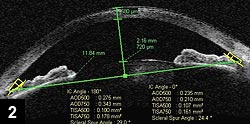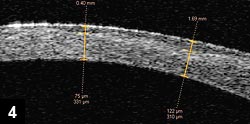Anterior segment OCT useful in preop, postop evaluations of refractive surgery patients
Guest columnists explain how the technology helps evaluate angles, corneal pathologies, flaps and complications.
Introduction
 Amar Agarwal |
Optical coherence tomography is a technique that uses light to create a two-dimensional cross-section image of the eye. This technique allows for imaging of either the anterior segment or the posterior segment. Decision-making for refractive surgery is aided by evaluations in either the preoperative or postoperative stages. My special guests in this column are Amin Ashrafzadeh, MD, and Roger F. Steinert, MD, who discuss the Visante anterior segment OCT in evaluation of patients being considered for excimer laser treatment.
Amar Agarwal, MS, FRCS, FRCOphth
OSN Complications Consult Editor
Optical coherence tomography is a non-contact, real-time technique that uses low infrared laser energy to image structures. The more commonly used retinal OCT uses 820-nm light, which allows for excellent tissue penetration to the level of the retina. The Visante anterior segment OCT (Carl Zeiss Meditec) utilizes 1310-nm light, which has greater absorption resulting in limited penetration. This allows for increased intensity of the light as decreased amounts reach the retina. As such, with the Visante, the light is 20 times more intense, giving a much greater signal-to-noise ratio. This increased intensity allows for increasing the speed in imaging 20 times, yet retaining similar signal-to-noise ratio levels as the retinal OCT but with resultant decreased motion artifact. Additionally, the 1310-nm light has reduced scattering and therefore allows better penetration through tissue such as an opaque cornea and sclera. This results in better evaluation of the anterior segment and visualization of the angle and, to a lesser degree, the ciliary body.
Modes in Visante OCT
There are two modes to the Visante OCT: standard-resolution imaging and high-resolution imaging. Standard-resolution imaging provides a broader view of the anterior segment with a 16-mm-wide and 6-mm-deep image. This provides a full overview of the anterior segment including the cornea, anterior chamber, iris and both angles. The high-resolution imaging mode provides a more detailed image with dimensions of 10 mm wide and 3 mm deep. This mode is more appropriate for imaging of the cornea and any segment in need of detailed evaluation.
In evaluation of a patient for LASIK, the Visante is able to provide preoperative pachymetric mapping of the cornea, evaluation of the angles and evaluation of any corneal pathology. In evaluation of patients after LASIK, detailed anatomical data may be obtained to further guide in clinical decision- making.
The pachymetric mapping of the cornea combined with the corneal topographic map provides a powerful set of information. This information may be especially important in cases in which the possibility of corneal ectasia is raised.
Angle evaluation
When managing a refractive patient, one must never overlook the ophthalmic care that may be required. A 55-year-old female patient with 2 D of hyperopia presented for LASIK. Preoperative Visante evaluation (Figure 1) revealed narrow angles of approximately 10·. Moderate anterior bowing of the posterior iris pigmented line was noted. Peripheral iridotomies were performed weeks before her LASIK surgery. After the iridotomy (Figure 2), despite the fact that the pupil was larger compared with the preop image, the angles were significantly more open at approximately 25° with near complete flattening of the posterior pigmented iris lines.
As compared with standard slit lamp gonioscopic examination of the eye, the angle was identified quantitatively with multiple methods of calculated angle area and distance measurements. Trabecular-iris space area (TISA) and angle opening distance (AOD) were measured at 500 µm and 750 µm away from the scleral spur. The AOD is defined as the distance perpendicularly away from the trabecular meshwork/endothelial surface to the surface of the iris. The TISA is a trapezoidal area bordered by the AOD at 500 µm or 750 µm, and a line drawn perpendicularly from the scleral spur to the iris.
Corneal pathology
A 44-year-old female contact lens user had developed a corneal ulcer in her dominant eye 5 years earlier with complete healing and resolution; however, best corrected visual acuity had been reduced to 20/40. The patient was seeking consultation for LASIK. Her cornea was noted to have a paracentral scar with concordant flattening on the topographic map. Her preoperative refraction was –4.00 –1.50 × 110, leading to 20/40 vision. The Visante was used to measure the depth of tissue loss, epithelial filling and the corneal scar (Figure 3). A decision was made to correct this eye conservatively with a stepwise approach. As such, treatment of only –2.25 –1.50 × 110 was delivered via photorefractive keratectomy.
 Preoperative evaluation of the anterior segment of a patient with 2 D of hyperopia in consideration of LASIK. Images: Agarwal A |  Evaluation after iridotomy of the patient in Figure 1, showing greater opening of the angle and flattening of the posterior pigmented iris line. |
 Corneal scar showing loss of corneal tissue and epithelium filling. |  Corneal scar of the patient in Figure 3 after PRK. |
Six months after PRK, the patient was elated with 20/25+ uncorrected visual acuity that was correctable to 20/20 with plano –0.75 × 135. The corneal scar, although not obliterated by the excimer laser, was reduced in thickness and opacity intensity (Figure 4). Additionally, the epithelial pooling over the depressed scar area was also noted to be significantly less. It can also be noted that Bowman’s membrane, noted as a black line under the white epithelium in Figure 3, was obliterated and nonexistent in Figure 4 after PRK.
Flap evaluation
In evaluation of postoperative LASIK patients who may be considering enhancement, the Visante can provide detailed information on corneal flap shape and regularity that would be essential to the safety of the procedure.
A 38-year-old man, who had LASIK 8 years ago at another clinic with no records available, presented for LASIK enhancement. The Visante was able to clearly demonstrate the flap and residual stromal bed thickness. The patient was assured that LASIK enhancement via lifting of the flap could be performed. The patient, however, developed epithelial ingrowth after the enhancement. The patient, with uncorrected 20/15 vision after the enhancement, chose not to have any intervention.
Summary
As demonstrated in these cases, the Visante anterior segment OCT is useful in evaluation of LASIK patients preoperatively. Evaluation of the corneal pachymetric map as an adjunct to the corneal topographic map and quantitative assessment of the angles are examples. The postoperative care is also enhanced in evaluation of patients for enhancement and also for management of complications.
For more information:
- Amar Agarwal, MS, FRCS, FRCOphth is director of Dr. Agarwal’s Group of Eye Hospitals. Prof. Agarwal is the author of several books published by SLACK, Incorporated, publisher of Ocular Surgery News, including Phaco Nightmares: Conquering Cataract Catastrophes, Bimanual Phaco: Mastering the Phakonit/MICS Technique, Dry Eye: A Practical Guide to Ocular Surface Disorders and Stem Cell Surgery, and Presbyopia: A Surgical Textbook. He can be reached at 19 Cathedral Road, Chennai 600 086, India; fax: 91-44-28115871; e-mail: dragarwal@vsnl.com; Web site: www.dragarwal.com.
- Roger F. Steinert, MD, can be reached at Eye Institute at University of California, Irvine, 118 Med Surge I, Irvine, CA 92697-4375; 949-824-0327; fax: 949-824-4015; e-mail: steinert@uci.edu.
Reference:
- Steinert RF, Huang D. Anterior segment optical coherence tomography. Thorofare, NJ: SLACK Incorporated; 2008.









